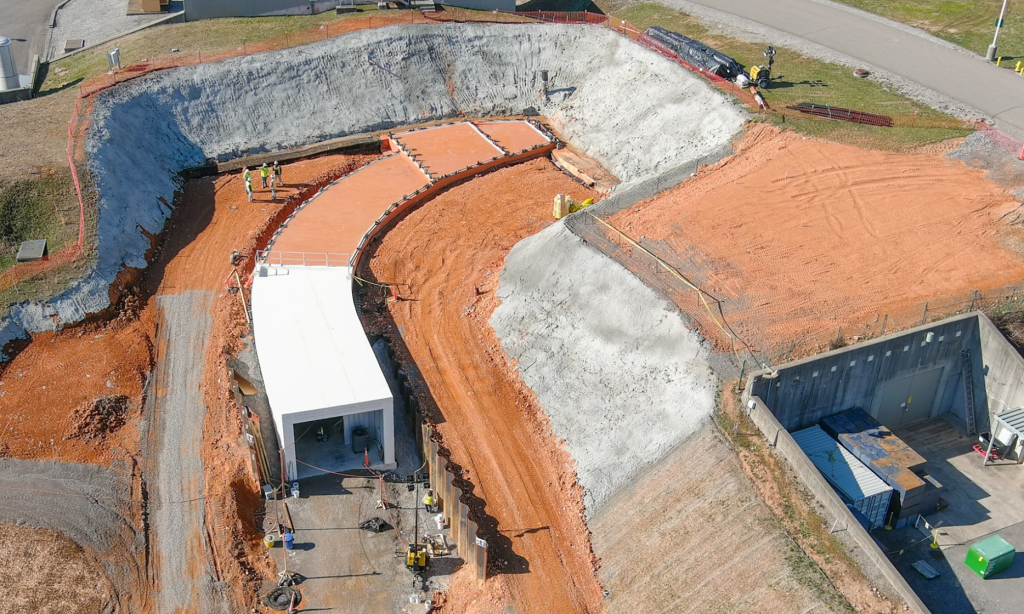What's the best way to wake a giant after a long nap? "Very carefully, and with a lot of planning," said a grinning John Galambos. He was the project director for the Proton Power Upgrade project, or PPU, at Oak Ridge National Laboratory until his retirement in July after more than 40 years at the lab. "It was an A-team effort that will benefit science and technology development for decades to come."
The "giant" Galambos referred to is the Spallation Neutron Source, or SNS, the nation's leading source of pulsed neutron beams for research, which was recently restarted after nine months of upgrade work. The planned extended outage permitted installing and testing seven additional cryogenic modules and their 28 additional power units, as well as the supporting systems - all designed to increase the power capabilities of the 362-yard-long linear accelerator complex, or linac.
The beefed-up linac will initially provide the First Target Station at SNS up to about 40% more power than its original 1.4 megawatts, as much as 2.0 megawatts. More power will produce more neutrons and increase the pace of scientific discovery across a wide range of materials and technologies. To handle the increased power, the accumulator ring and target at the SNS complex were also upgraded with new electronics and supporting systems.
Eventually, the linac will also power the SNS's Second Target Station, or STS, to produce the world's brightest "cold" neutrons and enable studies of smaller and more complex materials.
Neutrons are widely used in research, such as in developing new vaccines, analyzing advanced batteries and operating national security systems. Neutron scattering at the SNS and ORNL's High Flux Isotope Reactor, or HFIR, is an essential technique for advancing materials research to support the U.S. economy and offer solutions to challenges in energy, transportation, biotechnology, quantum and other research areas.
Overcoming obstacles
Despite the global pandemic, supply chain issues and other unprecedented challenges, the ORNL team still managed to complete the PPU project ahead of schedule and under budget.
"The PPU project exceeded all expectations in how it's come together nearly three years ahead of schedule despite enormous technological, logistical and even global health challenges," said Jens Dilling, associate laboratory director for the Neutron Science Directorate. "Thanks to the tremendous efforts of the ORNL staff and our collaborative partners at Jefferson Lab and Fermi National Laboratory, the SNS will continue to operate as the world's foremost center for pulsed neutron research."
The future looks brighter
The STS will produce the world's highest peak brightness of neutrons, tailored for probing soft matter such as polymers and biological materials, and complex engineering materials. STS will house up to 24 new instrument stations - starting with eight - for unprecedented experiments on complex matter.
Mark Champion is the new PPU project director after serving as project manager since PPU's inception in 2016. "We want to acknowledge and thank the project team for all of their hard work and dedication," he said. "But we don't plan to rest on our laurels. There's more 'gas in the tank,' and we need to keep pushing the technology to enable even more and better science in the future."
Jon Taylor, division director for ORNL's Neutron Scattering Division, said, "I know our neutron scientists and the external researchers working at the SNS are already benefitting from the record 1.7 megawatts enabled by the PPU project in 2023. They've seen the improvements that added accelerator power does for their experiments, and they really want the full 2.0 megawatts we're going to provide."
Traveling 167,000 miles per second
The linac uses electromagnetic fields to steer and accelerate protons to around 90% of the speed of light, or about 167,000 miles per second. These protons pass through large steering magnets that guide them into an accumulator ring that is 271 yards in circumference. There they are bunched together and directed 60 times per second at a target filled with 20 tons of liquid mercury. This is where the protons knock neutrons loose from the mercury atoms. Finally, these "free" neutrons are steered down beamlines to instruments where the scientists conduct their experiments.
The first one-third of the linac operates at room temperature, while the remainder uses 81 superconducting cavities inside cryomodules cooled with liquid helium to just two degrees above absolute zero (minus 460 degrees Fahrenheit).

A key aspect of the project involved building a curved tunnel extension leading from the existing accelerator toward the location of the planned Second Target Station. Workers added about 3,000 square feet of concrete tunnel, capped off by an 18-foot-thick wall of more than 7,000 concrete blocks to provide radiation shielding during normal SNS beamline operations. Other tunnel extension-related construction tasks included installing associated structures, roofing, geomembrane liner, tunnel waterproofing, electrical, fire alarm, ventilation systems and controls.
The long installation outage at SNS concluded in April 2024. An external accelerator readiness review was conducted the following month, and authorization for beam commissioning and routine operations to resume was granted in early June. Beam commissioning was then completed in less than 30 days.
"The post-PPU power ramp up plan calls for a gradual increase in beam power on target and annual neutron production hours up to 2.0 MW and 5,000 hours, respectively, in fiscal year 2027. However, now that our sleeping giant is already fully awake and working hard, it may be possible to increase the beam power earlier, which would benefit the science productivity at the facility," said Champion.
The project is preparing a closeout report, lessons learned, and other documentation as required to support a U.S. Department of Energy project completion review in early 2025.
SNS and HFIR are DOE Office of Science user facilities.
UT-Battelle manages ORNL for DOE's Office of Science, the single largest supporter of basic research in the physical sciences in the United States. The Office of Science is working to address some of the most pressing challenges of our time. For more information, please visit energy.gov/science. - Paul Boisvert






